History
The theoretical foundation for the practical application of MBS was laid in the work "Разрушения и заграждения" (1931) by the Soviet military engineer Dmitry Karbyshev. [1] [2]
During the Second World War (1939 - 1945), and especially the Eastern Front (1941 - 1945), wide use in all types of combat found mines and explosive barrages. For their arrangement in the Battle of Moscow, the Soviet troops for the first time in 1941 were used barrage squads, later called mobile barrage squads, which subsequently were successfully used in other operations of the Red Army of the Soviet Union.
After the Battle of Kursk (1943) on the basis of the experience gained, it was concluded that the army command needed a permanent specialized reserve of engineering units, which would have the means of mechanization of mines, large quantities of mines and explosives of various types. As a consequence, the MBS became a mandatory element of operational structure of the Soviet troops, and in 1942 - 1943 the tactics of MBS in the offensive and defensive were practiced. [1] [2] During the Eastern Front, the Red Army expended more than 70,000,000 different mines, including about 30,000,000 anti-tank mines.
Basic provisions
The composition and equipment of a squad is determined by its objectives in combat or an operation, the availability of available forces and equipment, the composition of the enemy's troops, and the conditions on the ground. [1] When setting a mission, the MBS receives data on the area of location, movement routes, mine lines, and possible courses of action (bands). [2]
On defense, the MBS holds behind the first echelon of its troops in the most likely direction of the enemy's main strike in full readiness to move out to the breakout areas. The primary purpose of the MBS in defensive operations is considered to be: [1]
- Rapid erection of mines and explosive barrages and the organization of destruction on the directions of the enemy's breakthrough into the depths of the defense, in the areas of landing of marines and the like;
- Covering joints and flanks of their troops with engineering barrages, as well as deployment points for counterattacks and counterstrikes;
- Increasing the density of barrages in critical areas of first-echelon unit defense.
On the offensive, the MBS follows the first echelon of troops in readiness to set up barriers at the mines indicated to it.
On the offensive, the tasks of the MBS are usually: [1]
- Organizing roadblocks in likely directions of enemy counterattacks and counterattacks;
- Covering the flanks of the strike groups and the entry points of the second echelons with engineering barrages;
- Setting up barrages in first-echelon units while securing them in captured positions.
An MBS formation can be established not only in the ground forces, but also to solve certain tasks within other branches of the armed forces and branches of the military. For example, in the Navy, the tasks of barrages on the high seas are performed by barrage ship units. [1] In the Strategic Rocket Forces of Russia, units are formed to cover approaches to the facilities of the position area, block enemy reconnaissance groups and landing zones of marines. [1] While conventional units and formations usually organize one MBS, troops defending a stretch of coastline create an additional MBS with watercraft or aircraft for placing anti-landing mines in the water. In military formations, two or three MBSs are created, one of which is equipped with helicopter vehicles. [1]
The organizational structure of the armies of NATO member states does not provide for the deployment and use of MBS. [1]

The Battle of Lake Khasan, also known as the Changkufeng Incident in China and Japan, was an attempted military incursion by Manchukuo, a Japanese puppet state, into the territory claimed and controlled by the Soviet Union. That incursion was founded in the Japanese belief that the Soviet Union had misinterpreted the demarcation of the boundary based on the Treaty of Peking between Imperial Russia and Qing China and the subsequent supplementary agreements on demarcation and tampered with the demarcation markers. Japanese forces occupied the disputed area but withdrew after heavy fighting and a diplomatic settlement.
The 75th Guards Rifle Division was a Red Army infantry division during World War II and afterwards, which later became the 75th Guards Tank Division and was finally disbanded in the 1990s.
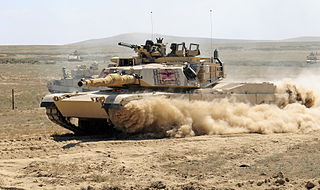
Mobile defense is a manoeuvre by military units that repulses an attack by the use of well-planned counter-attacks by the defender, which seeks to avoid a pitched battle.

The 97th Guards Mechanized Brigade was a rifle, and then a motor-rifle division of the Soviet Union's Army, before becoming a mechanized brigade of the Ukrainian Ground Forces, based in Slavuta in western Ukraine.
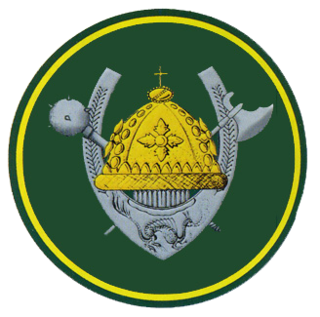
The 36th Army was a military formation of the Red Army and the Soviet Ground Forces, formed twice.
The 1st Guards Zvenigorod–Bucharest Red Banner Order of Suvorov Airborne Division was a division of the Soviet Airborne Troops. The division was first formed in December 1942 and fought in the Battle of the Dnieper, the Battle of the Korsun–Cherkassy Pocket, the Uman–Botoșani offensive, the second Jassy–Kishinev offensive, the Battle of Debrecen, the siege of Budapest and the Prague offensive. In August 1945 it was sent east and fought in the Soviet invasion of Manchuria. The division became the 124th Guards Rifle Division in November 1945 and disbanded in 1956.
The 83rd Rifle Division was an infantry division of the Red Army during World War II.
The 1st Airborne Corps was an airborne corps of the Red Army during World War II. It fought in the Battle of Kiev, the Battle of Moscow and in the Battle of Demyansk.
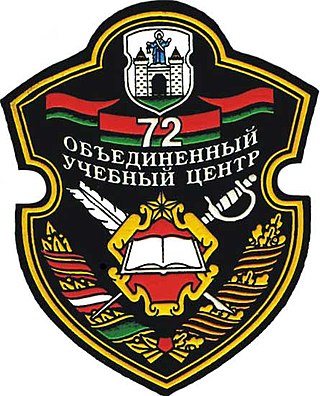
The 72nd Guards Joint Training Centre is a training centre of the Belarus Armed Forces. It trains warrant officers and junior specialists for the Belarus Armed Forces and is based in Borisov. The centre is currently led by Colonel Igor Korol. The 72nd Guards Joint Training Centre traces its history back to the Soviet 120th Rifle Division. For its actions during the Yelnya Offensive, the division became the 6th Guards Rifle Division in September 1941. In November 1945, the division became the 15th Guards Mechanized Division. On 15 May 1957, it became the 47th Guards Tank Division. The division became a training unit in 1960 and was renamed the 45th Guards Tank Training Division in 1965. In 1987, it became the 72nd Guards District Training Centre. In 1992, it was taken over by Belarus and became the 72nd Guards Joint Training Centre.

A Military Unit Number is a numeric alternate designation for military units in the armed forces and internal troops of post-Soviet states, originally used by those of the Soviet Union.
The Orel Military District was a military district of the Russian Soviet Federative Socialist Republic and the Soviet Union. Established in 1918 during the Russian Civil War, the district was disbanded after the end of the war in 1922. It was reestablished during the pre-World War II Soviet buildup in 1938. At the beginning of Operation Typhoon, the German attack on Moscow in October 1941, the district headquarters in the city of Orel was surprised by the German attack and hastily forced to flee the city. After most of the district's territory was occupied, it was disbanded. The district was reformed in 1943 after the area was recaptured and disbanded with the end of World War II in 1945.

The 41st Guards Rocket Division was a division of the Soviet and Russian Strategic Rocket Forces, active from 1961 to 2001.
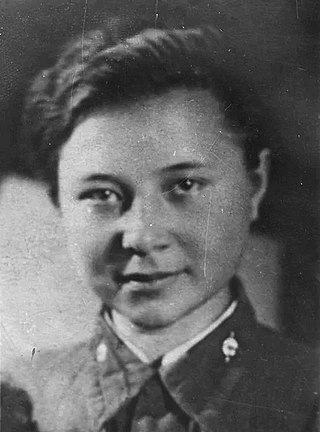
Mariya Semyonovna Polivanova was a Soviet sniper during World War II. On 14 August 1942, surrounded by German soldiers whilst she and her colleague Natalya Kovshova had only two grenades left, they set them off, killing themselves and surrounding German soldiers. For their bravery she and Kovshova were posthumously awarded the title Hero of the Soviet Union on 14 February 1943.
The Moscow Air Defense Front was an air defense front of the National Air Defense Forces, responsible for the air defense of Moscow during World War II. It was formed in April 1942 in response to predictions of a German bomber concentration against Moscow, and its units were used to cover troops and rear areas on the front after the halting of German air raids against that city. In June 1943 it was reorganized as the Special Moscow Air Defense Army.
The 1st Army was a field army of the Red Army during the Russian Civil War. The 1st Army was formed twice. The first formation was between the beginning of March 1918 and May as a reaction to the Austro-German occupation of Ukraine. The second formation was created on June 19, 1918, as a part of the Eastern Front and from August 15, 1919 as a part of the Turkestan Front. The Army was disbanded in January 1921.
The 58th Guards Rifle Division was an elite Guards infantry division of the Red Army during World War II.
The Donbas–Rostov Strategic Defensive Operation was a defensive operation of the Southern Front and the left wing of the South–Western Front of the Red Army on the territory of Donbas during the World War II. During it, the Donbas and Rostov front–line defensive operations were carried out.

The 9th Guards Artillery Kielce-Berlin Order of Kutuzov, Bogdan Khmelnitsky, Alexander Nevsky and the Red Star Brigade is an artillery brigade of the Russian Ground Forces. During the years of the Great Patriotic War - a tactical formation of the Red Army. Since 1946, the brigade formed part of the Soviet Ground Forces. Since 1992 it has been located at Luga, Leningrad Oblast.
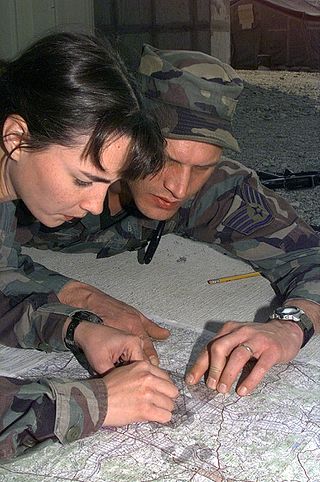
Area defense is a method of positional defensive warfare described in the U.S. Army's combat manuals of the 1960s and 1970s. After 1982 the term "positional defense" replaced it.
Barrage is a military term covering a wide range of structures, devices, or measures for destroying something to constrain or impede the movement of troops and forces.










